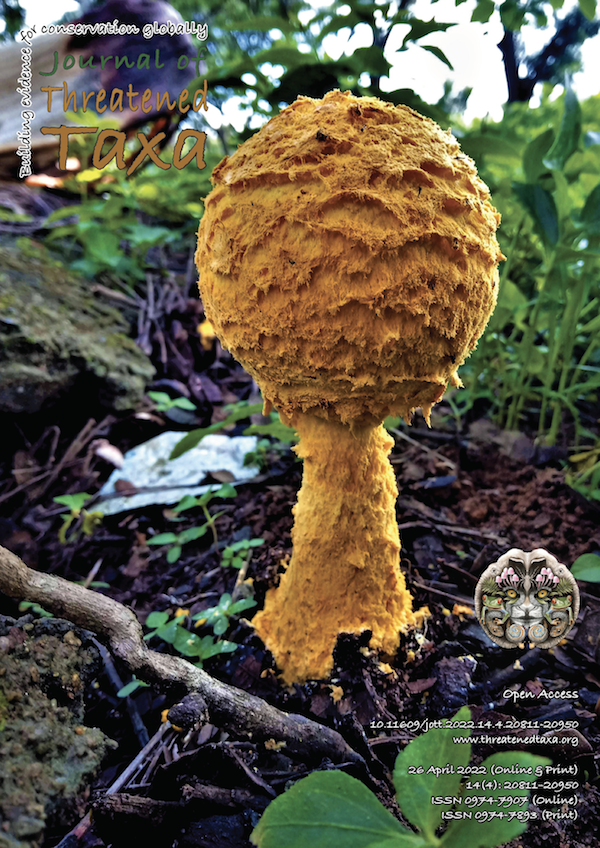Management of traumatic ulcerative keratitis in a Red Serow
Main Article Content
Abstract
Red Serow Capricornis rubidus is an elusive herbivore native to the montane forests of the Himalaya. Currently it is categorized as ‘Vulnerable’ in the IUCN Red List and placed under Schedule I species of the Wildlife Protection Act, 1972. A serow was presented with complaints of mild inappetence, irritability, sporadic scratching of head over the enclosure barrier and serous ocular discharge from the left eye. Based on detail clinical examination, the animal was diagnosed with unilateral conjunctivitis, corneal oedema, and ulcerative keratitis. A combination of Xylazine @ 1.5mg/ kg body weight and Zolatile® (zolazepam and tiletamine) @ 2.5 mg/kg body weight was used to chemically restrain the animal, followed by auriculo-palpebral nerve block using 1 ml of 2 % lignocaine hydrochloride. The affected eye was adequately cleaned with isotonic sterile Normal Saline solution (NSS). Combination of 0.5 ml of ceftriaxone and 0.5 ml of flubiprofen was injected into upper and lower palpebral conjunctiva. The cornea and the third eyelid flap were carefully sutured using 5-0 and 3-0 Vicryl, respectively. Finally, tarsorrhaphy was done using 2-0 nylon. Post-operative care consisted of an antibiotic regimen of Cephalaxin @ 20 mg/ kg body weight b-i.d-twice in a day for seven days along with probiotic supplement (Vizylac®) and Vitamin A capsules (Aquasol A®) orally once daily for the next 30 days. The animal showed complete recovery within 30 days of proper treatment, monitoring, care and management.
Article Details

This work is licensed under a Creative Commons Attribution 4.0 International License.
Authors own the copyright to the articles published in JoTT. This is indicated explicitly in each publication. The authors grant permission to the publisher Wildlife Information Liaison Development (WILD) Society to publish the article in the Journal of Threatened Taxa. The authors recognize WILD as the original publisher, and to sell hard copies of the Journal and article to any buyer. JoTT is registered under the Creative Commons Attribution 4.0 International License (CC BY), which allows authors to retain copyright ownership. Under this license the authors allow anyone to download, cite, use the data, modify, reprint, copy and distribute provided the authors and source of publication are credited through appropriate citations (e.g., Son et al. (2016). Bats (Mammalia: Chiroptera) of the southeastern Truong Son Mountains, Quang Ngai Province, Vietnam. Journal of Threatened Taxa 8(7): 8953–8969. https://doi.org/10.11609/jott.2785.8.7.8953-8969). Users of the data do not require specific permission from the authors or the publisher.
References
Acharya, M., A. Gour & A. Dave (2020). Commentary: Tarsorrhaphy: A stitch in time. Indian Journal of Opthalmology 68(1): 33–34.
Aryal, A. (2005). Status and Conservation of Himalayan Serow (Capricornis sumatraensis thar) in Annapurna Conservation Area of Nepal-A Final Report. Report Submitted to Rufford Small Grants Foundation, UK.
Gellat, K.N. & J.P. Gellat (1994). Handbook of Small Animal Surgery. Vol. I- Extraocular Procedures. Pergamon Press, London, 300 pp.
Gellat, K.N. (2014). Conjunctiva. MSD Vet Manual. University of Florida, USA.
Kumari, K., S. Ganguly & P. Kumar (2016). Clinical Management of Conjunctivitis in Dog: A case history. Indian Journal of Animal Health 55(2): 167–168.
Palace, V.P., N. Khaper, Q. Qin & P.K. Singal (1999). Antioxidant potentials of vitamin A and carotenids and their relevance to heart disease. Free Radical Biology & Medicine 26(5–6): 746–61.
Parker, C.P. & L.M. Romero (2019). Chronic captivity stress in wild animals is highly species-specific. Conservation Physiology 7(1): coz093. https://doi.org/10.1093/conphys/coz093
Prater, S.H. (1993). The Book of Indian Animals. Bombay Natural History Society, India.
Rajak, S., J. Rajak & D. Selva (2015). Performing a Tarsorrhaphy. Community Eye Health 28(89): 10–11.
Schaller, G.B. (1979). Mountain monarchs-Wild sheep and goats of the Himalaya. Journal of Mammalogy 60(1): 240–241.
Senchyna, M. & M.B. Wax (2008). Quantitative Assessment of tear production: A review of methods and utility in dry eye drug discovery. Journal of Ocular Biology, Disease and Informatics 1(1): 1–6.
Shackleton, D.M. & S. Lovari (1997). Classification adopted for Caprine Survey. Wild sheep and goats and their relatives. IUCN. Downloaded on 23 July 2021. https://www.researchgate.net/profile/Sandro_Lovari/publication/283513659/_Classification_adopted_for_the_Caprine_survey/links/563cbc7008ae405111aa529a/Classification-adopted-for-the-Caprinae-survey.pdf
Shepherd, C. (2021). Capricornis rubidus. The IUCN Red List of Threatened Species. Downloaded on 09 October 2021: e.T3815A22151023 https://doi.org/10.2035/IUCN.UK.2021-3.RLTS.T3815TA22151023.en
Startup, F.G. (2008). Corneal ulceration in dog. Journal of Small Animal Practice 25(12): 737–752.
Zinder, R., R.Cooley, L.G. Vlad & J.A. Molnar (2019). Vitamin A and Wound Healing. Nutrition in clinical practice. American Society for Parental and Enteral Nutrition 34(6): 839–849.

